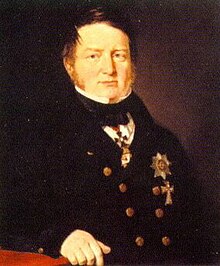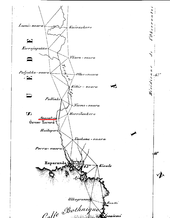Friedrich Georg Wilhelm Struve
Friedrich Georg Wilhelm von Struve , (since 1831) Struve ( Cyrillic Василий Яковлевич Струве * 15. April 1793 in Altona ; † 11 . Jul / 23. November 1864 . Greg in Pulkovo in Saint Petersburg ) was a German astronomer and surveyor who worked in the Baltic States and Russia . He published significant work on binary stars and carried out extensive geodetic surveys. His son Otto Struve also became an astronomer and his successor at the Pulkowo Observatory .
life and work
Wilhelm was born as the son of Jacob Struve in Altona, Holstein . His brothers were the later medicine professor Ludwig Struve and the philologist Karl Ludwig Struve .
In 1808 Wilhelm began studying at the University of Dorpat (now Tartu ) in Estonia , which was then part of Russia. He first studied philology , but after a few semesters switched to mathematics and astronomy . Struve graduated in 1813 with a doctorate to become a Dr. phil. from. In the same year he was hired by the university as an associate professor of astronomy and observer at the Dorpat observatory . In 1815 he married Emilie Wall (1796 to 1834) in Altona, she comes from a Huguenot family and was originally called Valles . The couple had twelve children, four of whom died early.
In 1818 Struve was appointed full professor and in 1820 director of the Dorpat observatory. From 1814 to 1821 he also taught mathematics. In 1824 a very powerful refractor from Fraunhofer with a 24.4 cm aperture was put into operation in Dorpat . In the following years Struve carried out intensive observations of binary stars , of which he discovered a large number himself. From 1824 to 1837 he took micrometric measurements on 2,714 binary stars. In 1827 he published a catalog with double stars, the Catalogus novus stellarum duplicium , and in 1837 his work Stellarum duplicium et multiplicium mensurae micrometricae appeared .
When his brother Ludwig died in 1828, he brought his ward , the later philologist Theodor Struve , to his home in Dorpat. In 1829 Struve was appointed "Collegiate Council" and two years later "Real State Council". With this appointment there was also an elevation to the nobility .
In addition to astronomy, Struve dealt with geodesy . From 1816 to 1819 he had participated in a triangulation of Livonia . In 1831 he published a description of the measurement of latitude in the Baltic provinces of Russia .
His wife died in 1834. In the same year he married Johanna Bartels (1807 to 1867), the daughter of the German mathematician Martin Bartels ; with her he had six other children.
Friedrich Georg Wilhelm Struve initially worked as a director at the Dorpat observatory. When the new observatory in Pulkowo was inaugurated in 1839 , Struve was appointed its first director. Here he continued his research on double stars, supported by his son Otto. In 1843 he determined the aberration of light and the parallax of the bright star Vega in the constellation Lyra .
After extensive preparatory work, Struve played a key role in founding the Russian Geographical Society in 1845 . He initiated an extensive triangulation, whereby he, together with Carl Tenner, had a chain of geodetic survey points built between Hammerfest in Norway and the Black Sea , the Struve Arch .
In 1847 he published studies on the structure of the Milky Way in the Études d'astronomie stellaire .
In 1856 Struve was appointed privy councilor.
In 1862 he retired for health reasons. His son Otto Struve took over the management of the Pulkowo observatory .
Wilhelm Struve died on July 11th . / November 23, 1864 greg. in Pulkowo and was buried in the public cemetery adjacent to the observatory.
Honors
He has received numerous honors for his work. He received the gold medal of the Royal Astronomical Society in 1826 and the Royal Medal of the Royal Society in 1827 . In the same year he became an external member of the Royal Society. In 1832 he became a corresponding member of the Prussian Academy of Sciences and a full member of the Russian Academy of Sciences in St. Petersburg. The Académie des Sciences in Paris accepted him as a corresponding member in 1833. In 1834 he was elected to the American Academy of Arts and Sciences , in 1835 to an external member of the Göttingen Academy of Sciences and the Royal Society of Edinburgh and in 1858 to a member of the Leopoldina and external member of the Bavarian Academy of Sciences .
In 1851 he was awarded the Prussian Order Pour le Mérite for Science and the Arts.
In memory of the astronomers of the Struve family, an impact crater on the moon and the asteroid (768) Struveana were named. He is also the namesake for the Pik Vasilija Struve in the Antarctic.
Descendants
His marriage to his first wife Emilie Wall (1796–1834) had 12 children, including:
- Otto Wilhelm von Struve (1819–1905), astronomer
- Heinrich Wilhelm von Struve (1822–1908), chemist
- Bernhard Wilhelm von Struve (1827–1889), governor of Astrakhan and Perm .
The second marriage with Johanna Bartels (1807 to 1867) had 6 children, including:
- Karl Wilhelm (Kyrill Wassiliwitsch) Struve (1835–1907), later Russian ambassador to Japan , the USA and the Netherlands .
His grandson Pjotr Berngardowitsch Struve (son of Bernhard Wilhelm von Struve) became known as a politician in Russia.
Astronomers are also among his descendants
- Hermann von Struve (1854–1920), grandson
- Ludwig von Struve (1858–1920), grandson
- Otto von Struve (1897–1963), great-grandson
as well as the politician and economist
- Peter Struve (1870–1944), grandson (son of Bernhard Wilhelm)
Fonts (selection)
- Observationes astronomicas ... Dorpatensis (Dorpat, 1817–39, 8 volumes)
- Catalogus novus stellarum duplicium et multiplicium (Dorpat, 1827)
- Stellarum duplicium et multiplicium mensurae micrometricae (St. Petersburg, 1837)
- Etudes d'astronomie stellaire (St. Petersburg, 1847) digitized
- Stellarum fixarum imprimis duplicium et multiplicium positiones mediae (St. Petersburg, 1852)
literature
- (C. Pritchard): Wilhelm Struve. , in: Astronomical Register , Vol. 3 (1865), pp. 89-104 (obituary, English).
- Friedrich Wilhelm August Argelander : Friedrich Georg Wilhelm Struve . In: Quarterly magazine of the astronomical society , 1st year, Wilhelm Engelmann, Leipzig 1866, pp. 31–52.
- Ludwig Stieda : Struve, Wilhelm von . In: Allgemeine Deutsche Biographie (ADB). Volume 36, Duncker & Humblot, Leipzig 1893, pp. 693-698.
Web links
- Publications by FGW Struve in the Astrophysics Data System
- Article by Friedrich Georg Wilhelm Struve in the Great Soviet Encyclopedia (BSE) , 3rd edition 1969–1978 (Russian)
- Album academicum of the Imperial University of Dorpat , Dorpat 1889
- Baltic Historical Commission (Ed.): Entry on Friedrich Georg Wilhelm Struve. In: BBLD - Baltic Biographical Lexicon digital
Individual evidence
- ↑ a b c N.N .: “On the 150th anniversary of the death of Friedrich Georg Wilhelm von Struve”. In: zfv - Journal for Geodesy, Geoinformation and Land Management , Volume 139, No. 6/2014, ISSN 1618-8950 , p. N-94.
- ↑ Vierteljahrsschrift of the Astronomical Society in 1904, S.642
- ^ Entry on Struve, Friedrich Georg Wilhelm (1793 - 1864) in the archive of the Royal Society , London
- ↑ Holger Krahnke: The members of the Academy of Sciences in Göttingen 1751-2001 (= Treatises of the Academy of Sciences in Göttingen, Philological-Historical Class. Volume 3, Vol. 246 = Treatises of the Academy of Sciences in Göttingen, Mathematical-Physical Class. Episode 3, vol. 50). Vandenhoeck & Ruprecht, Göttingen 2001, ISBN 3-525-82516-1 , p. 235.
- ↑ Order Pour le Mérite for Science and the Arts
| personal data | |
|---|---|
| SURNAME | Struve, Friedrich Georg Wilhelm |
| ALTERNATIVE NAMES | Struve, Wilhelm |
| BRIEF DESCRIPTION | German astronomer |
| DATE OF BIRTH | April 15, 1793 |
| PLACE OF BIRTH | Altona |
| DATE OF DEATH | November 23, 1864 |
| Place of death | Pulkovo near Saint Petersburg |


